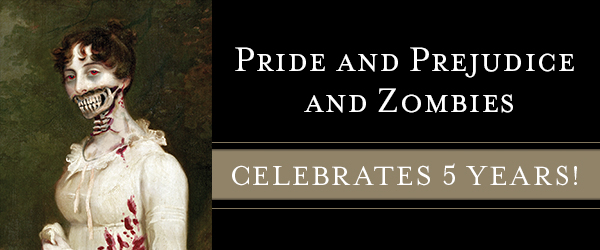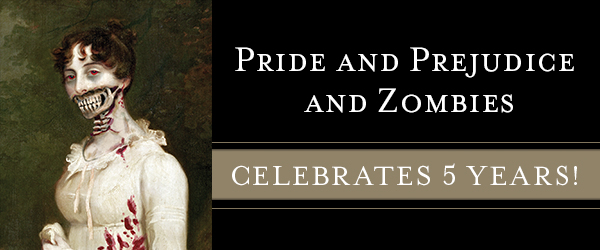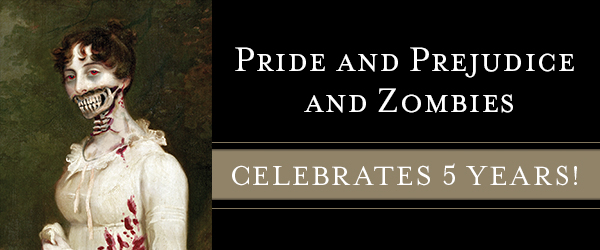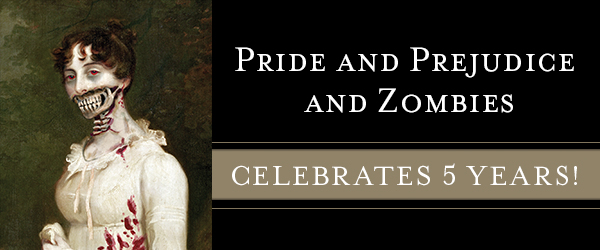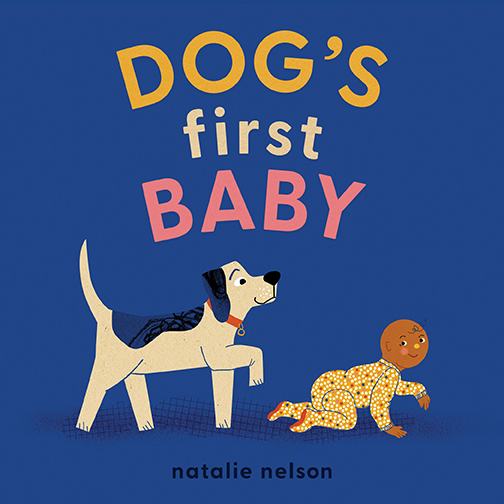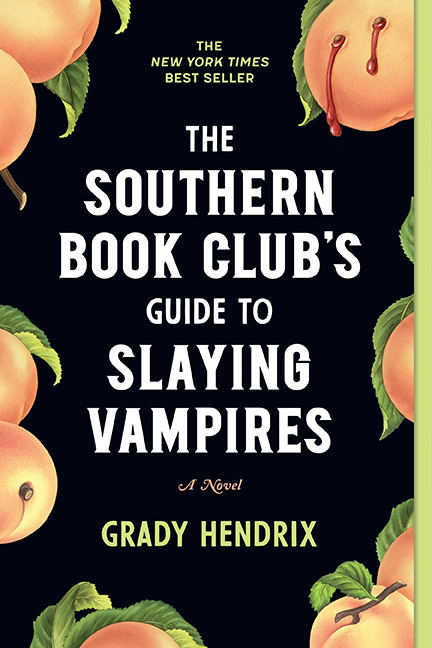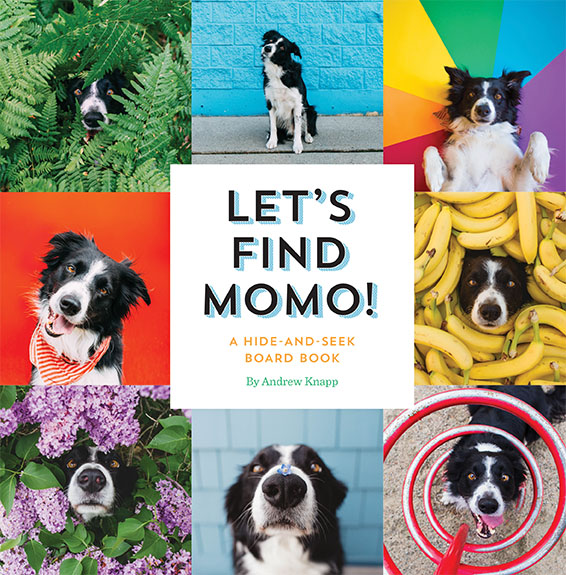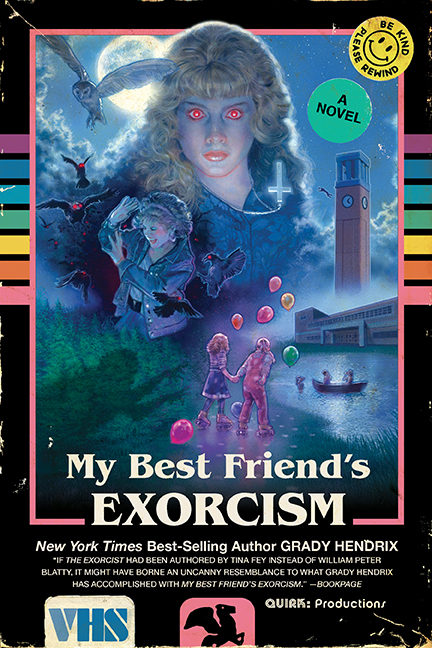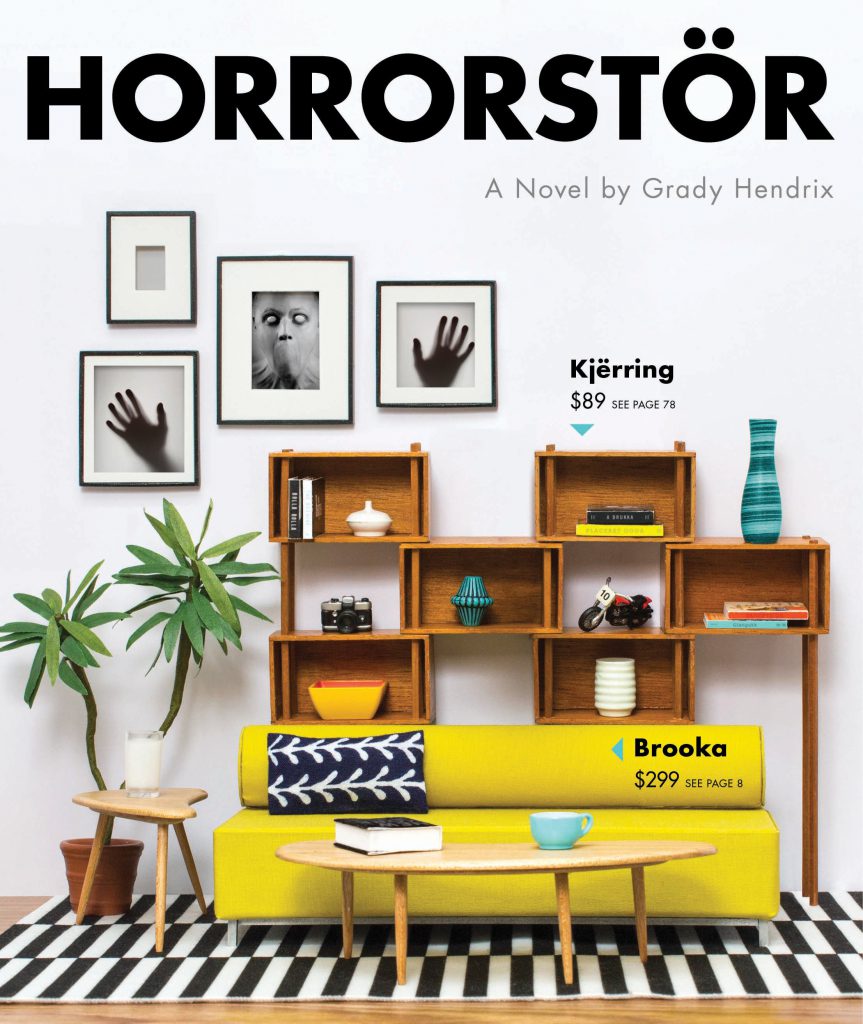Our Blog
Celebrating Five Years of Pride & Prejudice & Zombies
This month, Pride & Prejudice & Zombies turns five. A landmark book for Quirk, it was an enormous bestseller that took the literary world by storm and invented a new genre. The mashup!
To celebrate, we had Thom Dunn, a frequent Quirk contributor and blogger for places like Tor.com, write up a three part editorial about the history of Pride & Prejudice & Zombies. In his piece, he talks about the origins of the book, Quirk's venture into the mashup genre, and our jump into fiction.
You can check out all three parts below.
Pride & Prejudice & Zombies: Part 1 of 3
Pride & Prejudice & Zombies: Part 2 of 3
Pride & Prejudice & Zombies: Part 3 of 3
We're planning a lot more content over the course of the month, from guest blog posts to epic giveaways, so stay tuned! And speaking of those giveaways… we've got one right here! You can enter to win a copy of the Deluxe Heirloom Edition of Pride & Prejudice & Zombies.
Posted by Eric Smith
Pride & Prejudice & Zombies: Part 3 of 3
[Note: Be sure to read the first part in this series, here!]
The “Quirk Classics” line continued with Android Karenina (June 2010) and The Meowmorphosis (May 2011), but it was the success of Steve Hockensmith’s Pride & Prejudice & Zombies expanded universe stories that cemented the publisher’s reputation for clever and unique fiction. While they continued to produce plenty of off-beat non-fiction, editor Jason Rekulak realized that as long as they had a captive audience interested in original fiction, they should run with it. Besides, they didn’t want to be known as just the Pride & Prejudice & Zombies guys (even though the book continues to be the most well-loved of the literary mashup boom).
Quirk pursued the zombie front with 2009’s Night of the Living Trekkies by Kevin David Anderson and Sam Stall, which continued the humorous pop culture-riffing on a zombie attack. This original prose story swapped out Regency England for a comic book convention, replacing aristocratic mannerisms with, well, Trekkies.
In 2011, they released Miss Peregrine’s Home for Peculiar Children by Ransom Riggs. Like Grahame-Smith and Winters before him, Riggs had previously worked on one of Quirk’s non-fiction guides, The Sherlock Holmes Handbook. He had originally pitched Miss Peregrine’s to Quirk as a children’s picture book of bizarre photographs that he had collected, but Rekulak convinced Riggs to craft a narrative out of the photographs instead.
)
Rekulak’s suggestion, and his general commitment to original prose fiction, paid off quite well for the publisher. Miss Peregrine’s Home for Peculiar Children spent forty-five weeks at #1 on The New York Times’ Children’s Chapter Book List, and kept hanging around the top 10 bestsellers for another eighteen weeks after that. The movie rights to the book were sold to 20th Century Fox, and the sequel, Hollow City, was released in January 2014.
Fiction fans clearly had a penchant for unconventional stories tinged with elements of horror or macabre. While the literary mashup craze had died down, Rekulak figured that there was something else they could do in a similar vein without beating an undead horse, so to speak. So the company expanded their children’s offerings from strictly non-fiction with the launch of the Lovecraft Middle School series, middle-grade adventure stories with wonderful shape-shifting lenticular covers about a haunted middle school with a monstrous faculty. The first book in the series, Professor Gargoyle by Charles Gilman (aka “Totally Not Jason Rekulak”), was released in 2012, and was followed by The Slither Sisters, Teacher’s Pest, and Substitute Creature.
#
But Quirk did not ignore the contributions made by “Quirk Classics” writers Steve Hockensmith and Ben H. Winters — without whom their experiment into fiction publishing may not have been as successful. Hockensmith currently helms the Nick & Tesla series, which follows two eleven-year-old siblings (Nick and Tesla, naturally) who are sent to live with their mad scientist uncle after the disappearance of their parents (where chaos and hilarity ensue, of course). Each book features do-it-yourself science projects, to inspire the mad scientist in all of us. The first book, High Voltage Danger Lab, was released in November 2013, with two more due in 2014.
Meanwhile, Ben H. Winters was hard at work with his own excellent ideas for original novels. His horror story Bedbugs was released in 2011, but it was his 2012 novel The Last Policeman in 2012, the first in a trilogy about a police detective on the brink of the apocalypse, that really struck a chord with readers — and beyond. The book won the 2013 Edgar Award for Best Paperback Original and has been optioned for a television series. The sequel, Countdown City, followed in July 2013 and was a finalist for the Philip K. Dick Award as well as being named one of the best books of the year by NPR. The third and final book in the series, World of Trouble, will be released in July 2014.
Most recently, a peculiar manuscript found its way to the desk of editor Jason Rekulak: William Shakespeare’s Star Wars, by Ian Doescher. Rekulak was reticent at first, worried that the literary mashup trend had long since (or overstayed its welcome, depending on who you asked).
But mashups are a genre ripe with endless possibility, and for Rekulak, the book was too good to pass up. And verily, the similar so-simple-why-didn’t-I-think-of-it concept of William Shakespeare’s Star Wars was a hit; Doescher’s pitch-perfect pentameter took the galaxy far, far away to an entirely new stage. The intergalactic bard’s tale is shaping up to follow in the footsteps of its zombified progenitor, and Quirk already has plans to continue the rhythms of Jediambic pentameter with The Empire Striketh Back and The Jedi Doth Return.
But with more and more works entering the public domain — and the Pride & Prejudice & Zombies film still on the horizon — who knows what the future holds for Austen and her zombie brethren? The literary mashup craze was directly responsible for Quirk’s fiction successful publishing arm, and now, five years later, the company has firmly established itself as a premiere (if eccentric) innovator of the publishing industry.
While the recent trend may have burned out faster than a postapocalyptic wasteland awash in napalm, the rest of the company’s fiction output keeps getting better and better, and it’s more than enough to hold us over until the next smack-yourself-in-the-head-for-not-thinking-of-it-first mashup hit.
Posted by Thom Dunn
Pride & Prejudice & Zombies: Part 2 of 3
[Note: Be sure to read the first part in this series, here!]
Ben H. Winters’ working relationship with Quirk Books began with Worst-Case Scenario Pocket Guide: New York City in 2009. By complete coincidence, Winters was already living directly across the street from the Quirk offices when he met Rekulak and the rest of the team at Quirk through his literary agent. While it didn’t hurt to have a local guy on board for some projects, Winters received no preferential treatment when it came to Sense & Sensibility & Seamonsters, the first Quirk follow-up to Pride & Prejudice & Zombies: his strong proposal pitch and sample chapters for the follow-up are what ultimately sealed the deal, according to Rekulak.
Zombies were great, but Quirk didn’t want to simply rip themselves off in attempt to keep their sales up. Their first follow-up kept the Jane Austen piece of the puzzle in place and mashed it up with a different beast, this time with more alliteration. “Everyone was expecting vampires, which meant it couldn’t be vampires,” explained Winters. “Everyone was expecting Quirk to make a different writer its next victim — but Austen had worked so well the first time around. Next thing I knew, I was dog-earing my Barnes & Noble classics edition of Sense & Sensibility, writing cryptic phrases like ‘secretly a merman?’ in the margins.”
Sense & Sensibility & Seamonsters, by Ben H. Winters and Jane Austen, was announced via hilarious YouTube trailer on July 13, 2009 and released on September 15 of that same year, less than six months after the release of Pride & Prejudice & Zombies. While Winters’ method of marking up the margins of the book was certainly similar to Grahame-Smith’s, the ratio of Austen-to-Awesome was slightly different this time around. “The readers who gobbled up Zombies reported back to Quirk that as much as they loved the Jane Austen stuff, they wanted a little less of it,” Winters explained.
“So my mandate on Sea Monsters was to deliver a book that was 60 percent Austen and 40 percent me. Which made my life easier: I don't know if you've ever tried to describe a city built entirely underwater, where wealthy Britons attend costume balls dressed as pirates and government scientists conduct ill-advised experiments whereby fish organs are transplanted into men, but it takes a few paragraphs.”
While it wasn’t quite as successful as Pride & Prejudice & Zombies, Sense & Sensibility & Seamonsters still did tremendously well, including a lengthy stint on The New York Times bestseller list. “Once again, to the consternation of purists everywhere, the result is sheer delight,” said The AV Club. “Winters dives into these fantastical scenarios with gusto, inventing long scenes of mayhem and mystery where Seth Grahame-Smith, who adapted Pride & Prejudice, was far more restrained…But there’s no denying the page-turning satisfaction of this welcome sequel, which exceeds Pride & Prejudice & Zombies in cleverness and wit while continuing to pay proper homage to the deep emotions underlying the original text.”
For a publisher with a previously small fiction list that took a chance on an unprecedented idea, Quirk was seeing a very clear return on their investment. Sure, they had the words of the late Jane Austen on their side, but in just two novels, they had increasingly strayed from the source texts, and while they still weren’t 100% “original fiction,” these derivative works were undeniably transformative. How much further could they go? After all, no one makes a hit just by playing safe.
#
Comedy tends to work in “The Rule of 3s” — 1. Set it, 2. Establish it, 3. Change it. Quirk had clearly established themselves with Sense & Sensibility & Seamonsters, so the next trick was to find a way to change the pattern. But instead of putting all their kraken eggs in one basket, Quirk decided to cast a wider net as they scoured the watery depths of publishing for their next big hit. Why settle for just zombies, or just an Alternate Austen story, or just a classic literary mashup, when you can have all three?
Since MechaEmma didn’t quite roll off the tongue as well as they had hoped, Quirk sent Ben H. Winters on an interplanetary journey with Leo Tolstoy that would eventually culminate in Android Karenina. While they awaited his return, Rekulak also reached out to author Steve Hockensmith with the insane idea of producing a sequel to Pride & Prejudice & Zombies, that continued the alternate history adventures of everyone’s favorite zombie-slaying couple, Lizzie Bennet and Mr. Darcy. Hockensmith had previously written several books in a Sherlock Holmes – Wild West mashup series called Holmes on the Range, which proved his familiarity with genre tropes as well as mashup conventions, even as the genre of literature came into its own.
The “literary mashup” is itself a mashup of terms, but Winters found it to be a useful, it not entirely accurate description. “Strictly speaking, a mashup (like DJ Danger Mouse’s The Grey Album) combines elements from two pre-existing works (the Beatles White Album and Jay-Z’s Black Album). These ‘Quirk Classics’ instead place one pr-existing work in an entirely new context — meaning, for my book, the creepy, there’s-something-beneath-the-surface, the-ocean-will-swallow-us-all context that’s been a staple of Western Culture from The Odyssey through Jaws." H
ockensmith agreed that the books were well within an established tradition: “as far as this genre of mashups is concerned, it’s nothing new. In the 60s there was a movie called Robinson Crusoe on Mars. It’s been done before. It’s a way to have fun. It’s a way to play on the playground and in the amusement park of literature. If we’re going to start walling off parts of the playground and say, you’re not allowed to go there, I just think that’s a loss to everybody.”
Unfortunately, Jane Austen herself never wrote any additional adventures of Elizabeth Bennet, which meant that Hockensmith would have to write an entirely original novel based on the universe and characters that had been established in Pride & Prejudice & Zombies. But as Rekulak and Hockensmith spoke, they realized that the real gem of the storytelling was not in what happened after Lizzie and Mr. Darcy fell in love — but in what happened before. “The more we talked about it the more it swung around to being a prequel because of all of these fun, unanswered questions to play with – not all of which I answered purposely, but certainly we addressed some of them and the one that I found the most interesting was the transformation of Jane Austen’s beloved and demure Bennett sisters into fierce, zombie-beheading warriors. I thought, ‘Now, that would be a fun thing to watch happen, so let’s watch it happen,’” said Hockensmith.
Of course, while the zombie action was a crucial selling point, it was even more important to capture the romance that made the original Pride & Prejudice so timeless in the first place — a particularly difficult task, when readers already knew that the story’s heroine would end up with a man who wouldn’t even be featured in the prequel. “What I tried to do is use the romances that are in the book to explain in someway, or cast some light upon, why Jane and Elizabeth would be drawn to the men they ultimately are…For me Elizabeth has one true love, and that is Darcy. I was not going to mess with that. I wasn’t going to have the tragic pre-Darcy guy who is everything that Darcy is, but dies.”
Even though the prose was completely original and based on a derivative work, Hockensmith still made sure to include a dedication to Austen in the front of the book in hopes of satiating her legions of ardent fans. “I would say that I hope our affection for Jane Austen comes through,” he explained. “That's why it was very important to me that the dedication of the book be ‘For Jane: We kid because we love.’ For me, that captures what I'm all about. I'm not doing this to flip Jane Austen the bird. I'm a guest in her home.”
The resulting prequel, Pride & Prejudice & Zombies: Dawn of the Dreadfuls was released on March 23, 2010, and became a New York Times Bestseller. It was followed by a properly sequential sequel, Dreadfully Ever After, one year later. Although nothing could match the blockbuster sales of the original Pride & Prejudice & Zombies, the books were still remarkably successful by traditional standards.
Hockensmith, too, earned his praise for his ability to capture Austen’s voice, and create compelling and entertaining stories that built upon the established “Alternate Austen” universe in new and exciting ways.
Posted by Thom Dunn
Pride & Prejudice & Zombies: Part 1 of 3
[Ed. Note: To celebrate the five year anniversary of Pride & Prejudice & Zombies by Seth Grahame-Smith, Quirk will be hosting a number of PPZ related articles, giveaways, and editorials. This first piece, from frequent contributor Thom Dunn, is the first in a three part essay on the creation of Pride & Prejudice & Zombies, and Quirk's move to start publishing fiction. Enjoy! – Eric]
Back in 2009, vampires were still the "it" monster of the time, and Quirk Books, a small independent publisher out of Philadelphia founded in 2002, had done very little in terms of fiction books. In fact, when the company was founded, they were focused on everything but fiction. Non-fiction, novelty, and coffee table books were their wheelhouse, with “strikingly unconventional” topics and packages to amuse, entertain, and inform. The little publishing house had already put out some pretty big books, such as the “Worst Case Scenario” series, but Quirk Editor Jason Rekulak had always wanted to tell a different kind of story.
Quirk’s fiction output had been limited to a few Choose-Your-Own-Adventure parodies and several licensed interactive books — stories based on Batman and CSI that featured some kind of multimedia element. But Rekulak still had an itch to publish fiction — after all, that was a huge potential audience that they were missing out on. (At one point, Rekulak had been playing around with the idea of re-telling classic stories like Austen with monkeys, but, well, that never…evolved, as it were)
Around this same time, the Internet had come into its own as a creative space for storytellers. People had begun to explore the limits of derivative works, throwing together previously unrelated aesthetics and topics and finding an audience. These “mashups” (works created by combining two or more disparate things into a singular new work) were wildly popular, but when it came to copyright, they were a huge gray area. As long as the final product is arguably “transformative,” it’s still legal (or at least, no explicitly illegal) for it to exist. Still, even pre-Internet, the practice was fairly well-established as a subgenre of videos and music (think of classic hip-hop DJs sampling tracks). But a “literary mashup?” No such thing — and definitely not on a commercial or mainstream scale.
It was video mashups on YouTube that got Rekulak thinking: how could Quirk apply this same culture-clash idea to books? The first issue was finding works that were usable for a commercial remix (i.e., things without copyright). Rekulak compiled what he referred to as a “Takeout Menu” of public domain texts, and a second list of funny/weird things to mash them with. Then it was just a question of mixing and matching: War & Peace & Dinosaurs…nope…A Tale Of Two Ninja Cities…ehhhh…The Legend of Sleepy Hollow + The Four Horsemen of the Apocalypse…still too desperate.
Then he hit on Pride & Prejudice & Zombies. And that was it. "Once I had the title, I knew. I knew exactly what the book was going to be. And I just really wanted to read it!" said Rekulak.
#

Quirk had a well of freelance writing talent to pull from, but when it came to Pride & Prejudice & Zombies, they knew exactly where to turn: Seth Grahame-Smith, a then-32-year-old aspiring screenwriter in Los Angeles. Four years earlier, Grahame-Smith had pitched a book to Quirk that never quite panned out. The book wasn't right for the company at the time, but his voice was clever and unique in that Quirk-y way, so Jason Rekulak kept in touch with him for various work-for-hire gigs. By the time the idea for Pride & Prejudice & Zombies came to light, Grahame-Smith had already written several books for Quirk, including The Spider-Man Handbook, The Big Book of Porn, and, perhaps most importantly, How to Survive a Horror Movie, which zipped with Grahame-Smith’s quick wit and cemented him as an expert in horror genre tropes. At that point, his relationship with Quirk had existed entirely over the phone. “He [Jason] called me one day, out of the blue, very excitedly, and he said, ‘All I have is this title, and I can’t stop thinking about this title.’ And he said: ‘Pride and Prejudice and Zombies.’ For whatever reason, it just struck me as the most brilliant thing I’d ever heard,” said Grahame-Smith.
Grahame-Smith immediately went back and re-read the Jane Austen novel, which he hadn’t touched since he was about fourteen. Like many 14-year-old boys, he hadn’t not particularly cared for Elizabeth Bennet’s love life and Regency mannerisms, and nor for Austen’s 19th-century prose, on his first readthrough. But as he combed through text, marking notes in the margins about what he could change and where he could insert a shambling undead horde to add dramatic tension, Grahame-Smith genuinely began to understand the power and appeal of Austen’s work, “how brilliantly constructed it is, how full the characters are, and most importantly, how sarcastic and even a little mean-spirited Austen was in tearing down the conventions that she disapproved of."
As he worked through the book, Grahame-Smith began making more and more connections between the seemingly incongruous worlds of zombie attacks and English aristocracy. “You have little details everywhere, like the fact that there are soldiers encamped near Meryton in the original book, for seemingly no reason whatsoever. There’s just this huge regiment of soldiers there, and the obvious thing to do in this case is to say that, well, they’re there digging up graves and burning bodies and fighting the unmentionable menace,” he said. It’s almost as if Jane Austen was subconsciously setting us up for this. You have this sharp-tongued, fiercely independent heroine. It’s not a huge leap to say she’s a sharp-daggered, fiercely independent heroine. And you have Darcy, on the other side, who’s a pompous and privileged guy. And you say, all right, he’s a pompous and privileged slayer. And that’s how they battle it out with each other.”
From there, Grahame-Smith pasted the text of the original Pride & Prejudice into a document on his computer, and began adding in scenes and details — with his font colored red, of course — to flesh out this alternate history world full of “Unmentionables” and ninja swords. While the frequency of characters taking long strolls and carriage rides offered ample opportunity for zombie attacks, Grahame-Smith also understood the importance of keeping the stakes high at the center of the story; in true zombie story fashion, no one character was safe beyond the central protagonist. “If you kill someone in Chapter 7, it has repercussions in Chapter 56,” he noted. Still, he was wary to stray too far from the original text. “I didn’t want to mess with Jane Austen’s overall structure, because it’s a masterpiece. Who am I to screw with one of the most brilliantly plotted novels of all time?” Grahame-Smith’s two-colored text was an excellent visual aide in balancing out the zombie details with Austen’s luscious prose, and the book ultimately retained about 85% of the original text — plus a few gruesome character deaths for good measure.
#
On the surface, there is nothing contemporary — and certainly nothing technological — about inserting mindless undead creatures into a two hundred year-old book. But Pride & Prejudice & Zombies is in many ways a true a post-postmodern text, one that owes much of its existence and success to the Internet. Sure, there had been plenty of books before it that had revisited or repurposed existing popular stories in the name of deconstruction. But instead of taking cues from Thomas Pynchon, Pride & Prejudice & Zombies basically sprung out of YouTube: a “literary mashup.”
Semantics aside, it was clear from a very early stage that Quirk had a hit on their hands. The pre-release hype alone was nearly unprecedented; this was during a time when smartphones were becoming standard-issue, and the new social media whirlwind helped the word-of-mouth go viral. All it took was the opening lines of the book — “It is a truth universally acknowledged, that a zombie in possession of brains must be in want of more brains” — and a zombified portrait of a Regency-era woman to set the Internet aflame. A viral outbreak of genre mashups soon spread across the publishing field faster than a zombie outbreak — so much so that Quirk bumped Pride & Prejudice & Zombie’s release date up by two months to meet reader demand (and capitalize on the hype).
#
Still, in era when online crazes come and go in the blink of an eye, it’s remarkable that a two hundred year old book could cause so much of a stir. “People love Jane Austen," said Rekulak. "They love that book in a way they don't love other books. Austen fans are a special bunch. If there's a more loved novel in the English language, I don't know it. It's the template for so many stories, like a Rosetta Stone of Hollywood rom-coms."
The inner turmoil of Austen’s characters has always been universal — the way they grapple with sexuality, selfishness, swagger, and satisfaction — the addition of zombies provided an opportunity to externalize those conflicts. “Instead of taking herself in hand, the heroine now battles an actual monster,” noted Matthew Kaiser, an assistant professor of 19th century literature at Harvard University. “In literature, monsters are always projections of our own hidden impulses.”
Quirk was hit upon the perfect curveball element to juxtapose with Austen’s popularity. At the time, vampires were still very much the “in” monster of choice. The zombie craze was just over the horizon, but Quirk’s decision to use zombies had less to do with any carefully calculated sociological futurism, and more with the fact that, well, zombies were cool. To them, anyway. And pretty much no one else. “Growing up, I was always big into zombies,” said Rekulak. “Especially the George Romero films. I loved those. Now, five years later, zombie jokes aren’t as fresh. But we used to make zombie jokes in the office and socially all the time. It wasn’t that it was cool or anything. It was just what we talked about, something we always liked.”
Sociologists and media critics alike have theorized about the ways that popular monsters reflect our collective cultural fears. Quirk may have had a long-standing, genuine appreciation for zombies, but their breakout as lumbering harbingers of the cultural zeitgeist makes a lot of sense in the post-Bush wake of the 2008 financial crash. “Since the '20s, when White Zombie came out, and in the 1960s, with the Romero movies, zombies have always been an easy metaphor for whatever ills society finds itself up against,” observed author Seth Grahame-Smith. “They've been used to represent everything from rampant consumerism to the spread of communism. We live in an age when it's very easy to be afraid of everything that's going on in the world. There are these large groups of faceless people somewhere in the world, who mean to do us harm, and cannot be reasoned with. Zombies are sort of familiar territory.”
Cultural fears and absurd juxtapositions aside, Pride & Prejudice & Zombies still wouldn’t have worked if the elements hadn’t meshed. While our modern society might be far removed from Austen’s proper English setting (and even further removed, perhaps, from Grahame-Smith’s proper-English-setting-with-ninjas), the author discovered an even greater relevance to zombies as he worked on the book. “People realize that zombies are likable villains. You have sympathy for them. Zombies haven't chosen to be horrible. They've been infected, and now they're sort of doomed to walk the earth with this singular purpose of seeking out and infecting other people. So there's something tragic about them. And then of course there's something funny about them. They're stupid. They're so helpless […] That was what was so funny to me about this idea, is the fact that these people in Austen's books are kind of like zombies. They live in this bubble of extreme wealth and privilege, and they're so preoccupied with the little trivial nothings of their lives. As long as there's enough lamb for the dinner table, they could care less what's falling apart around them. So in this book, in this version, it literally is falling apart around them, and they sort of carry on writing letters to each other about hurt feelings and loves and passions and all these things.” Brad Pasanek, an 18th-century literature specialist at the University of Virginia, agreed, saying of the original novel that “The characters other than the protagonist are so often surrounded by people who aren’t fully human, like machines that keep repeating the same things over and over again. All those characters shuffling in and out of scenes, always frustrating the protagonists. It’s a crowded but eerie landscape. What’s wrong with those people? They don’t dance well but move in jerky fits. Oh, they are headed this way!"
#
As for the ninja elements, and why they worked out so well? I like to think that’s self-explanatory.
#

Within a week of its release on April 1, 2009, Pride & Prejudice & Zombies shot to #3 on The New York Times Bestseller list — not bad for a book with an initial print run of just 12,000 — and the bidding war for movie rights grew fierce before the book ever hit the stands. Even the critical response was overwhelmingly positive, and while its success could certainly be credited in part to Austen’s long-running popularity, Grahame-Smith’s contributions received their own share of accolades. According to The AV Club, “Grahame-Smith’s amendments add some interest, pathos, and essential motivation to Austen’s subplots…[He] simplifies Austen’s complex verbiage to a degree, but retains her enchanting style and vocabulary. When he politely turns the focus to ultraviolent mayhem—at one point, Elizabeth strangles one ninja with his own entrails and takes a bite from the fresh heart of another—the transition takes place with polished seamlessness. Such is the accomplishment of Pride & Prejudice & Zombies that after reveling in its timeless intrigue, it’s difficult to remember how Austen’s novel got along without the undead.” Entertainment Weekly went on to say, “The greater achievement of the book may lie in the satisfying desire it awakens to read the remix and the original side by side. Indeed, you'll miss out if you do not, so smartly does young Mr. Grahame-Smith insert himself in the thicket of curlicued manners that is Miss Austen's real comic theme.”
Quirk’s unconventional foray into fiction was successful, but all the media attention they received created pressure to repeat the success. The days of brainstorming phone calls were over; in the lightning-fast world of online trends, the publisher had to put out another book fast or risk losing steam. But even when picking up the publishing pace, Quirk knew (wisely) they couldn’t just pump out a pale imitation — whatever they did for a followup, they had a serious standard to maintain. Still, if they didn’t do it fast, then someone else certainly would: the infection was spreading. Public domain classics were snapped up and remixed, and mindless, shambling imitations from other companies began to flood the market (after all, it’s hard to make a claim of intellectual property when you’re already repurposing an existing text). Quirk knew they had a captive and hungry audience, but they weren’t exactly sure which part of Pride & Prejudice & Zombies they hungered for. Was it brains? Was it blood? Or was it just a chance to revisit that irresistible Austen charm?
Meanwhile, in the wake of his success, Seth Grahame-Smith received an irresistible offer from Grand Central Publishing for what would become Abraham Lincoln: Vampire Hunter, which meant that he’d be unavailable for the followup. Editor Jason Rekulak turned to his network of writers and literary agents and opened himself up to proposals for their next mashup project. A veritable legion of zombies authors jumped at the chance to have their pitches heard and hopefully hop on that mashup train to whatever cashcow it might lead them to. But as irreverent an idea as the burgeoning series was, it needed a seriously good writer to deliver on the product.
Quirk ultimately found their savior in the most unlikely of places: in an apartment that was literally across the street from their office.
-#-
Continue on to part 2!
Posted by Thom Dunn
Six Literary Alternatives to the Elf on a Shelf
You probably know about “The Elf on a Shelf,” a toy that parents can use to convince kids that a creepy elf is watching their every move. Which is basically the plot of George Orwell’s 1984, right? So we wondered…what other forms of Thing-on-a-Thing-based holiday behavior modification could be taken from classic and contemporary literature? The possiblities are endless… or at least six.
Posted by Rick Chillot
Boy Meets Literary World: Classic Books on the Classic Sitcom
Boy Meets World is one of the most beloved sitcoms from the 1990’s. Many of us grew up learning life lessons from Mr. Feeny and the rules of friendship from Cory and Shawn’s bromance. However, Boy Meets World also has many bookish lessons to share.
Posted by Maria Vicente
